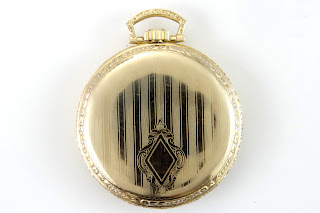 |
| Waltham 1894-Royal a 17J size 12 in Filled Gold 1903. |
Introduction
During the day a hundred years ago, pocket watch users would have been wearing suits in heavy worsted, flannel or tweeds perhaps varying in weight from 12 - 17 ounces or more (compared to 7 - 12 ounces for a modern business suit), in these clothes even a size 18 movement in an oversized case would probably not cause much of a bump, particularly if the suit was cut for comfort.
In the evening however finer fabrics were used (although not as light as current ones) and they would be a fashionably tight fit (especially Army Mess Dress) so a slimmer watch was required to avoid unsightly bulges.
This type is usually referred to as a "Dress Watch" and is usually the type of watch to go for if it will be worn with a dinner suit or military Mess dress.
Usually movements would be size 10 or 12, built to be thin and light weight and in a tightly fitting case, probably with a single back rather than double for slimness.
Many size 16's in American style slim cases can also work with evening dress, most of the better movements would be American or Swiss as English makers were generally slow to move to suitable movements.
What Material?
 |
| A typical design of case from the 1930s, this one holds a fairly rare 19J Rotherham pin set and is in 14 carat gold. Metal faces such as this were particularly favoured. |
Silver was also popular and might be more appropriate with some military Mess Dress.
 |
| A Rolled gold case showing a typical pattern found on American gold and base metal cases in the early 20th century. |
Many size 12s, such as the Waltham Royal at the top of the page were made in America for day to day use and as Dress Watches, although they are no where near as slim as some of the English and Swiss watches of the 1930s, the Rotherham shown right is closer to the American models than these super slim designs.
 |
| The Riverside Maximus above has a rare decorated case, which I suspect was intended for evening wear, it has a filled gold body, silver bezel and a silver back with yellow, green and rose gold inlay. |
Base metal with a chromium or other plating were very popular, particularly in the USA, and offered a cheap alternate for an occasionally used Dress Watch whilst something more substantial was used during the day.
Chains.
Advice on selecting a chain can be found in this blog post, but in general with evening dress a light weight chain is likely to be best, unless a big statement is to be made or perhaps if it is to be worn over a highly patterned waistcoat where a thin chain could get lost in which case a medium weight chain could be used. The very heavy chains are probably best avoided in the evening.
For a double breasted waistcoat you need a “slider” double or a longish single Albert (as the distance from the button-hole to the pockets is not equal) for a single breasted waistcoat a single or double will work.
Fob Watches.
 |
| An alternative to a Dress Watch, an English size 0 half hunter fob watch in silver. |
A small watch, carried in a trouser fob pocket is another option, particularly if a waistcoat is not being worn but finding suitable chains can be an issue - a snake chain would be best but of course does not enhance a waistcoat. A Cummerbund might also get in the way.


No comments:
Post a Comment
Note: only a member of this blog may post a comment.